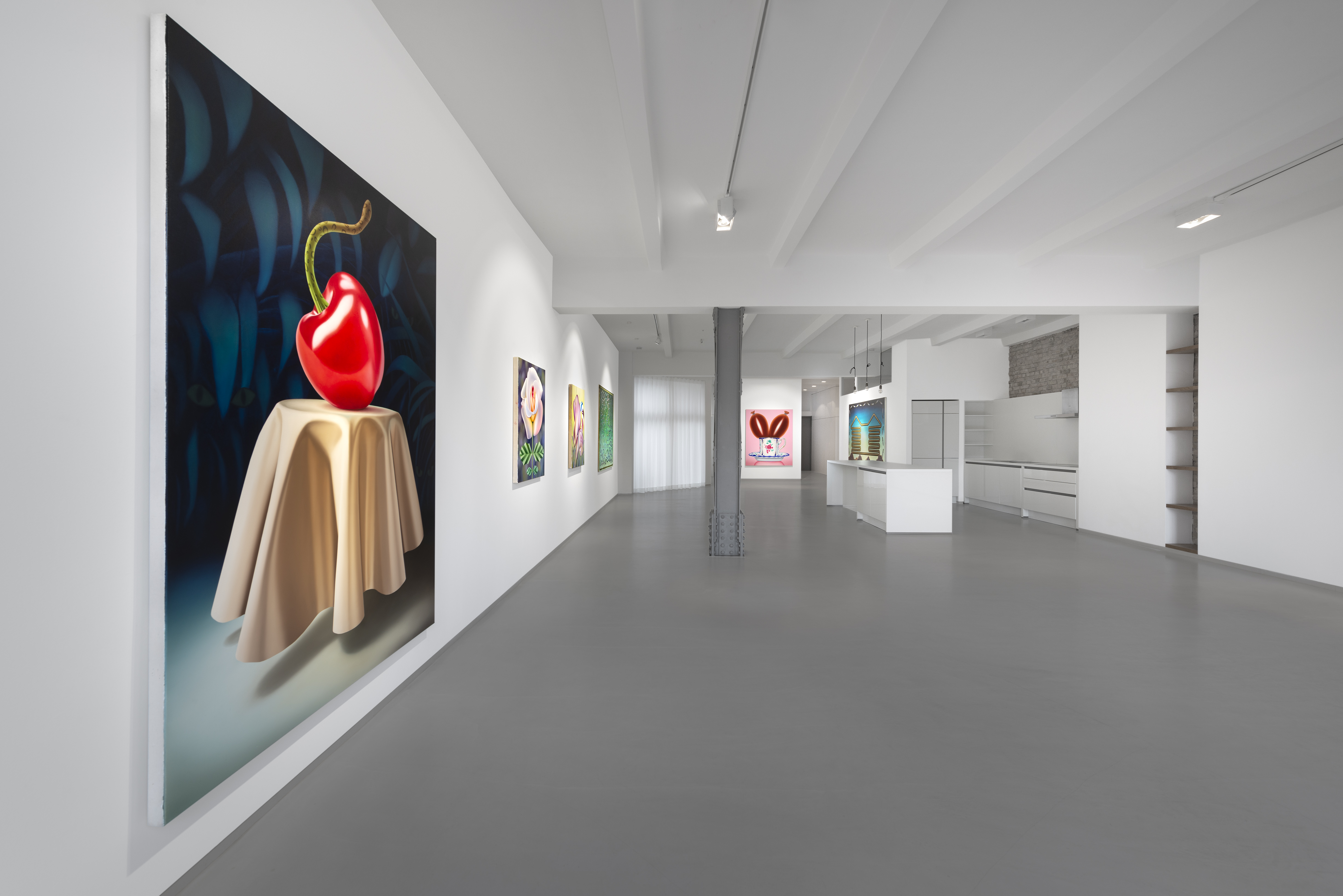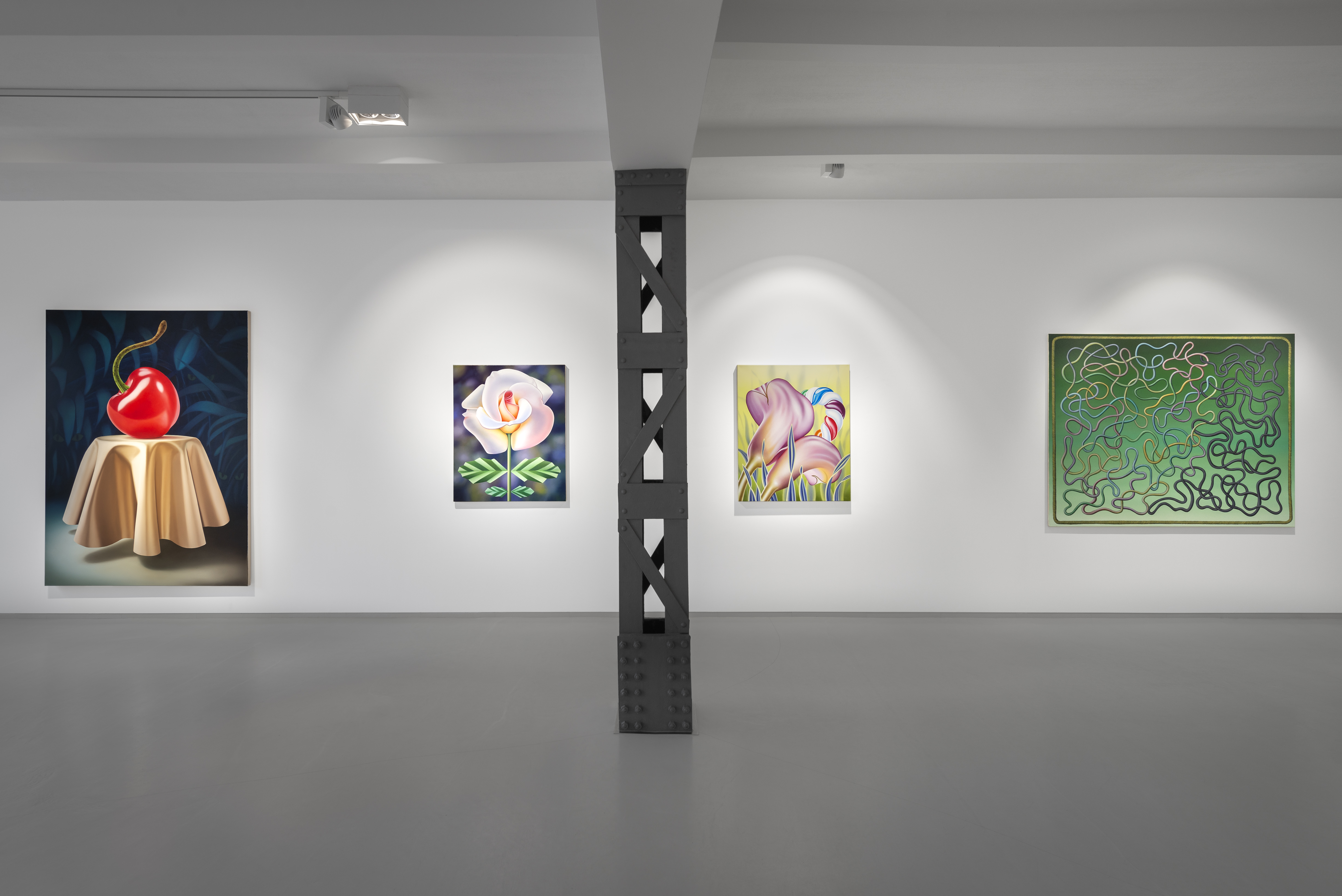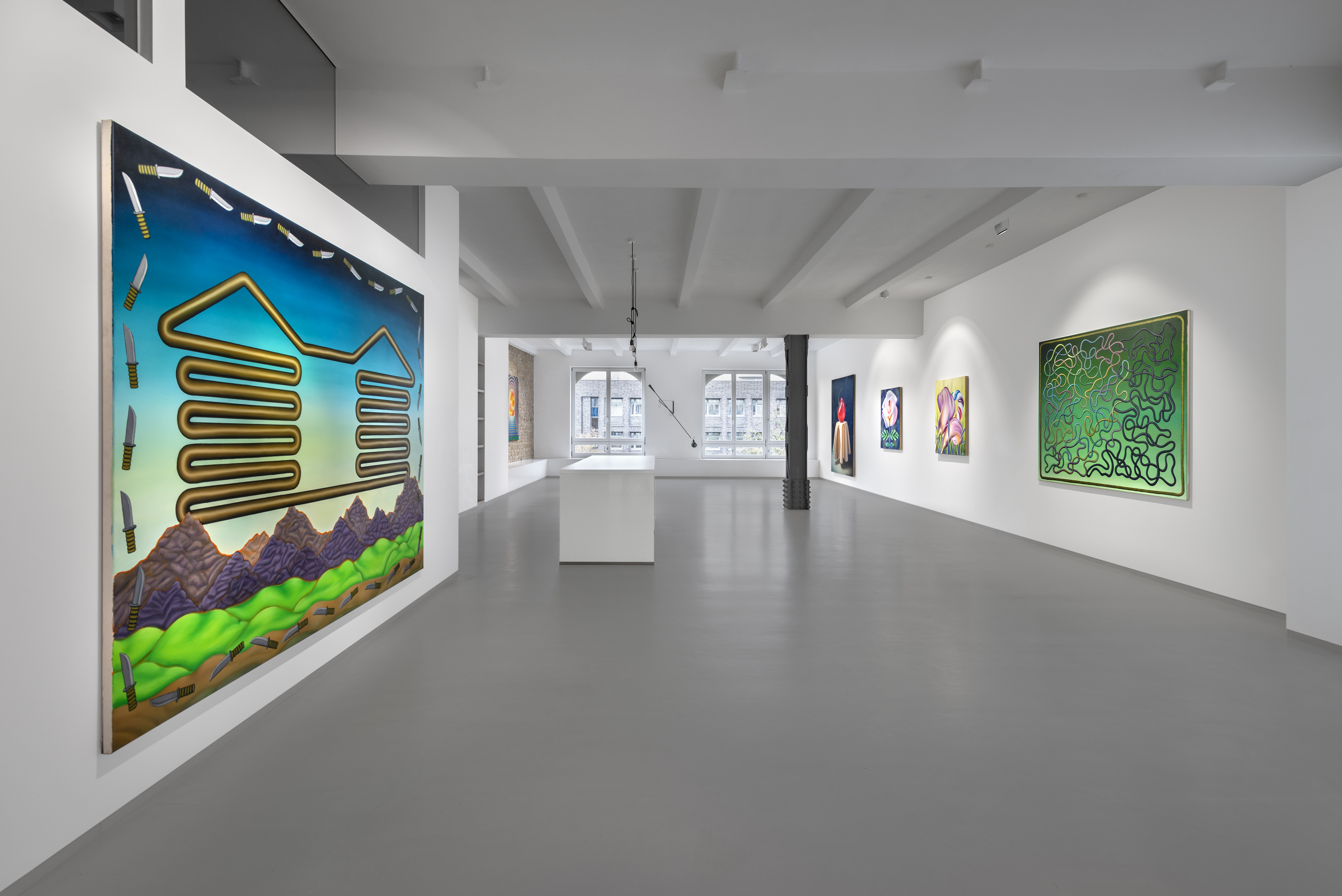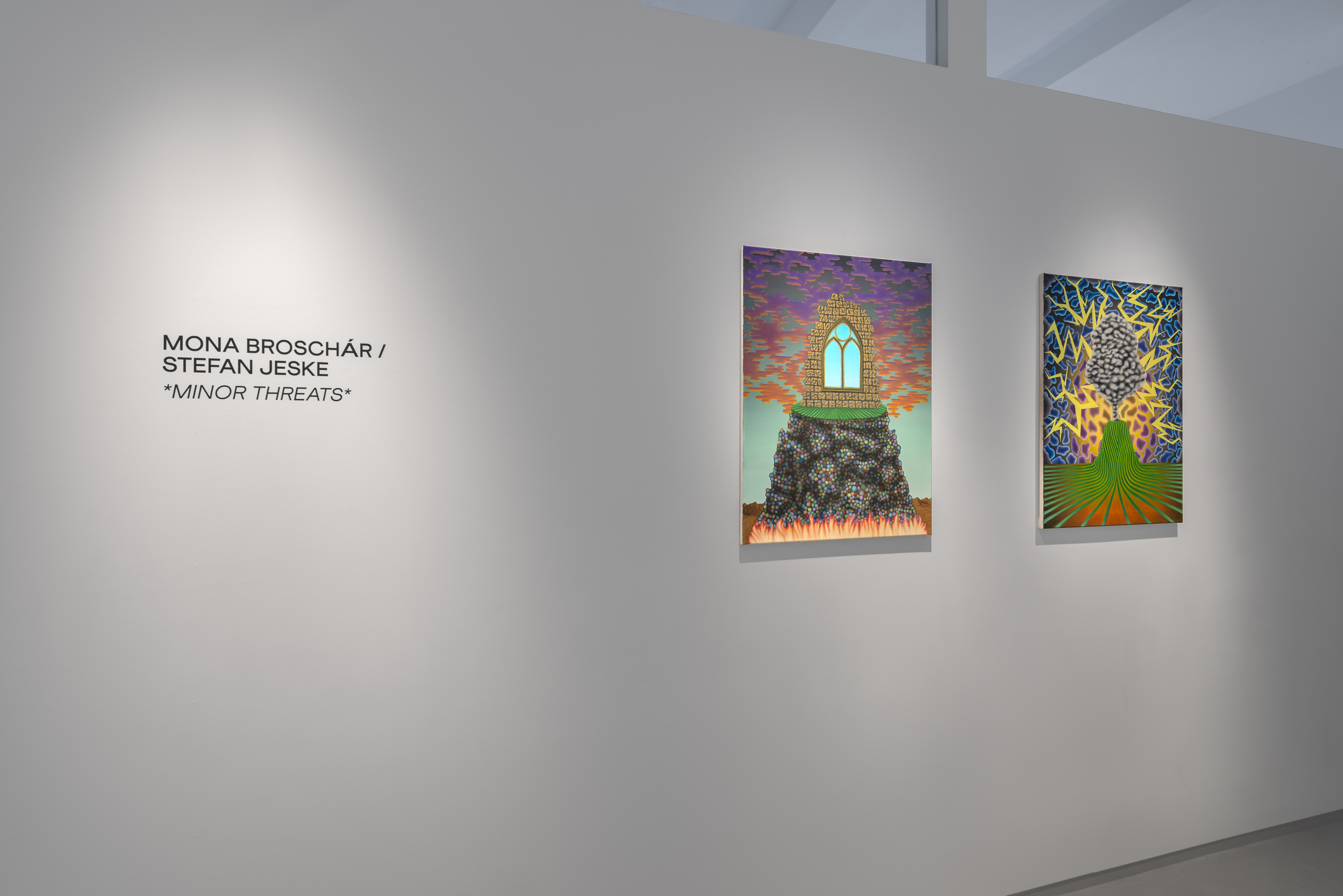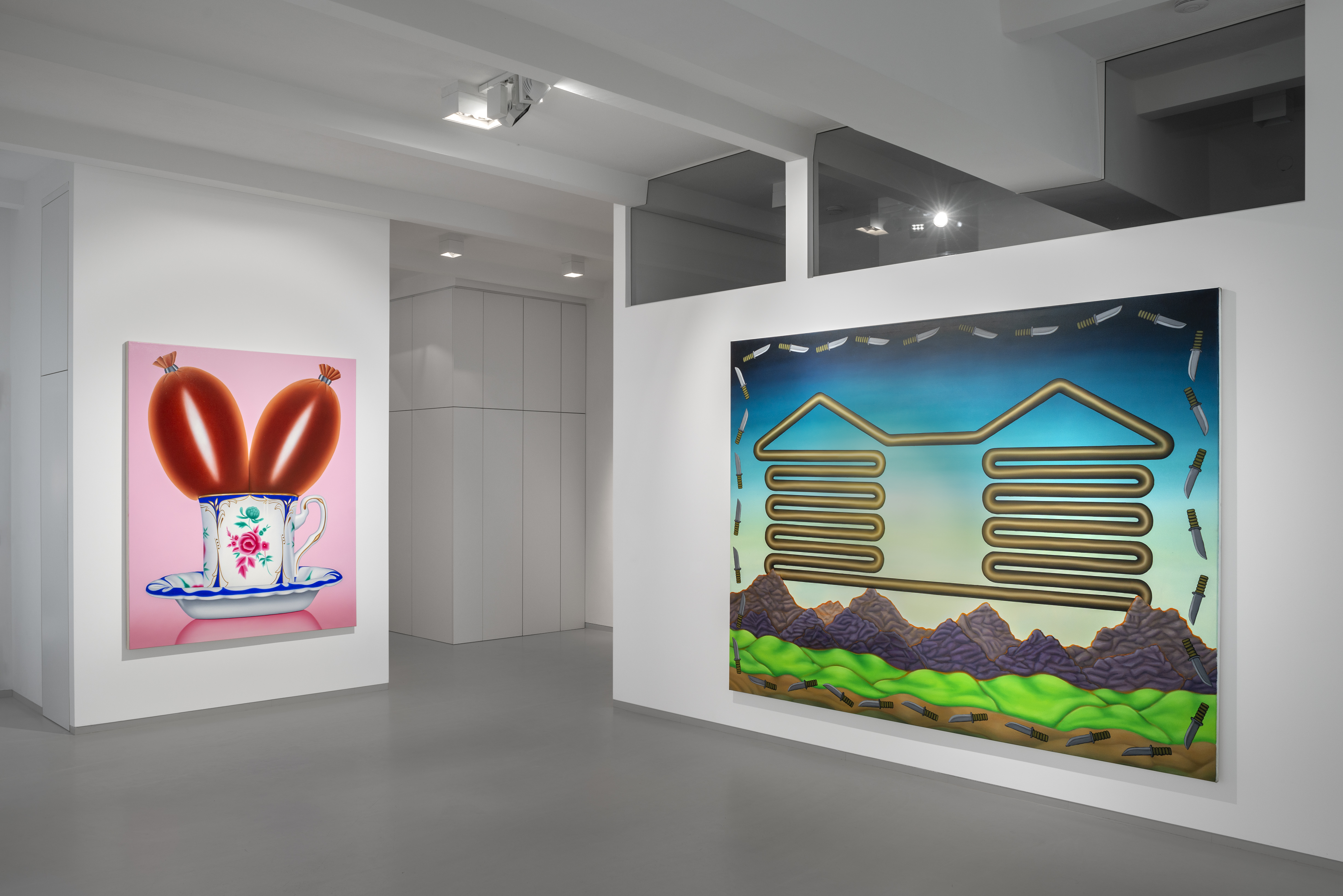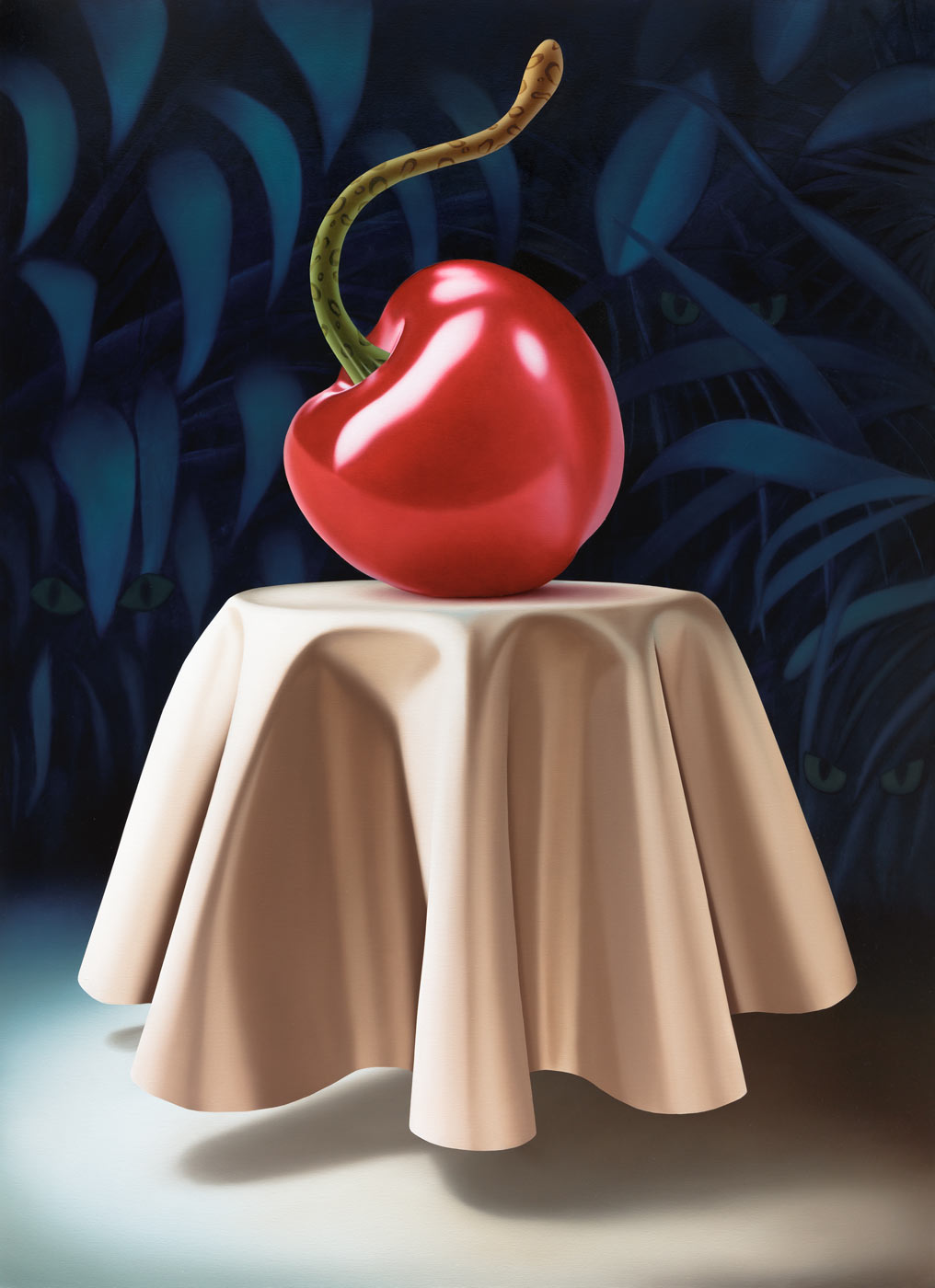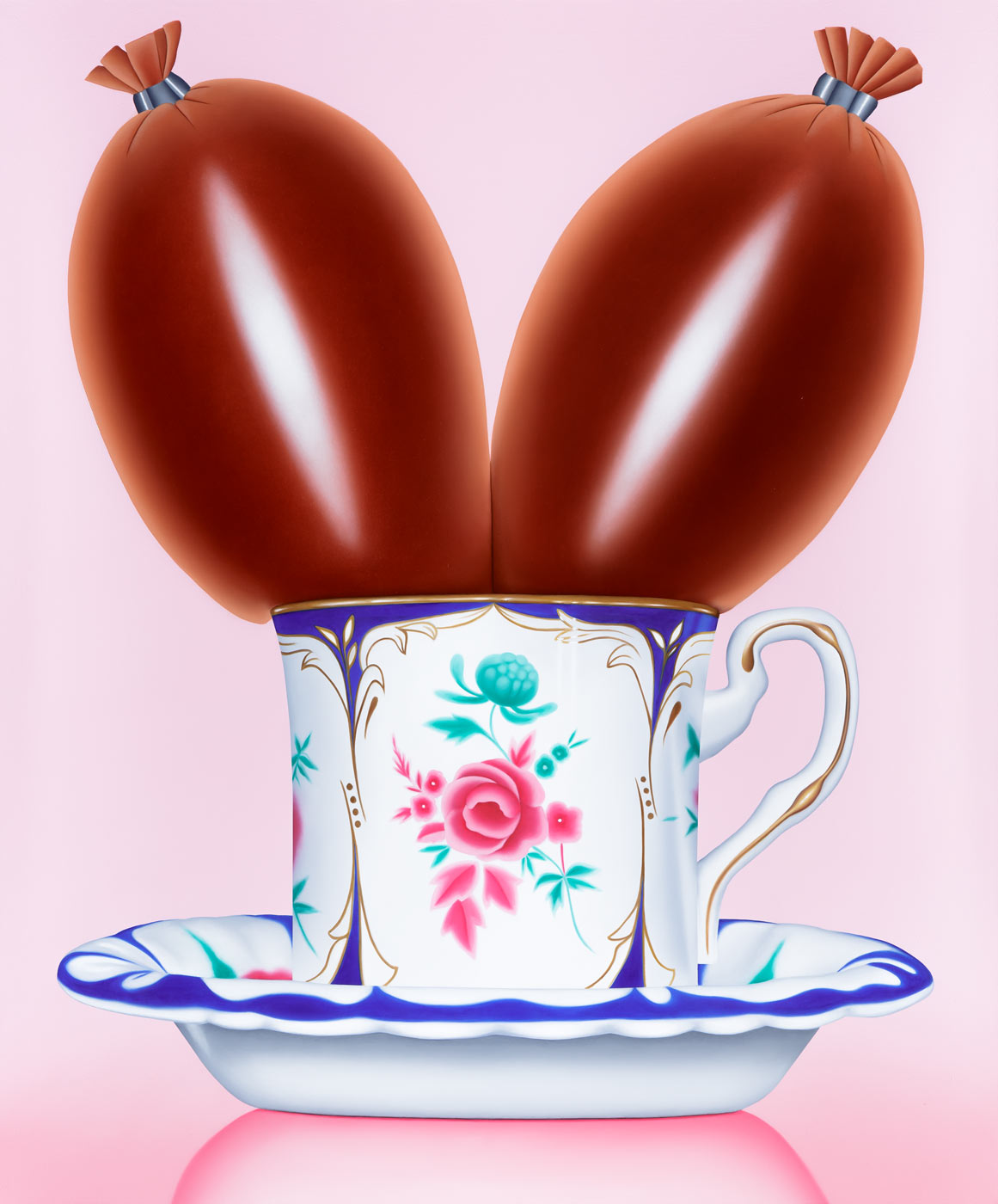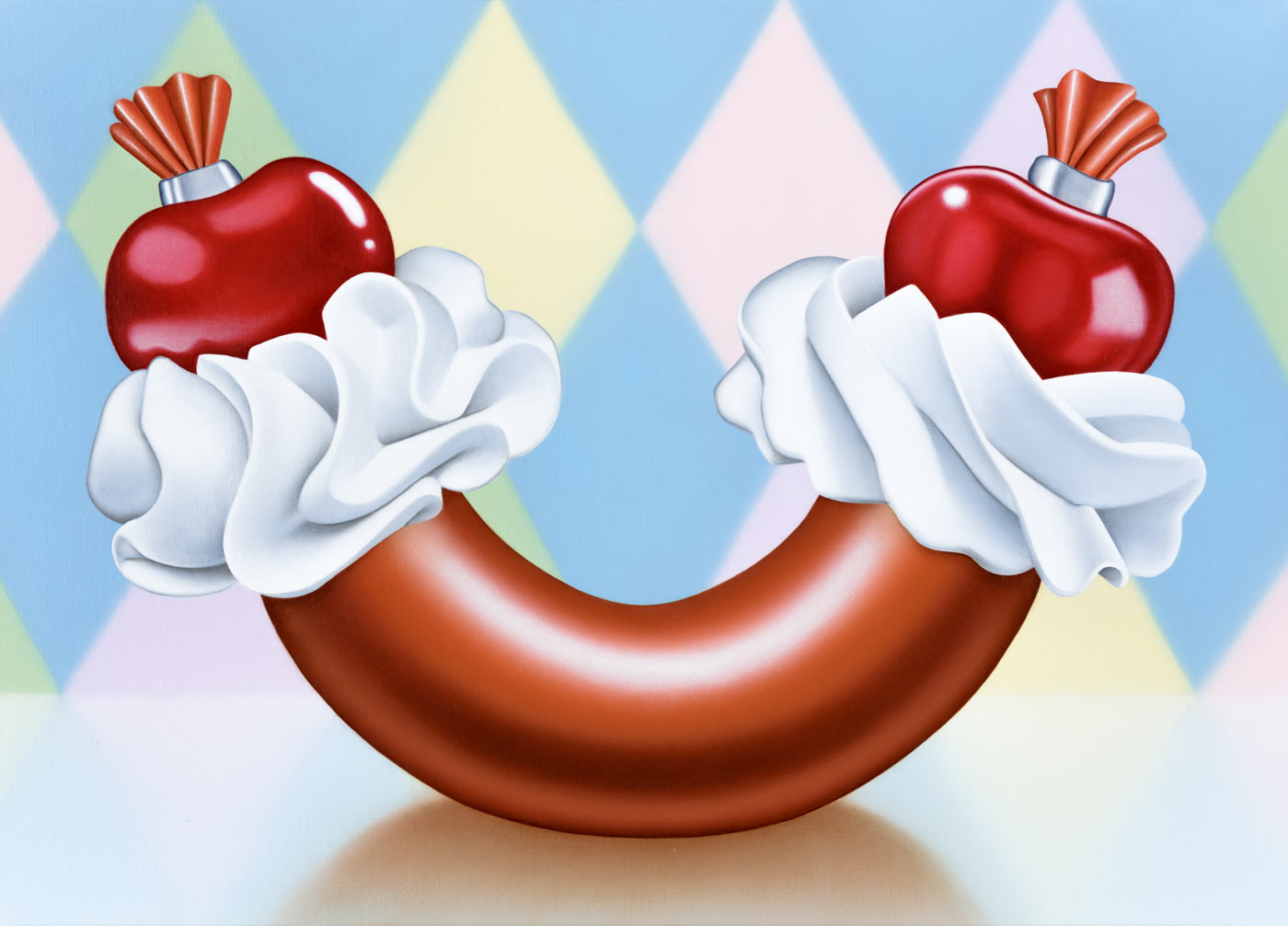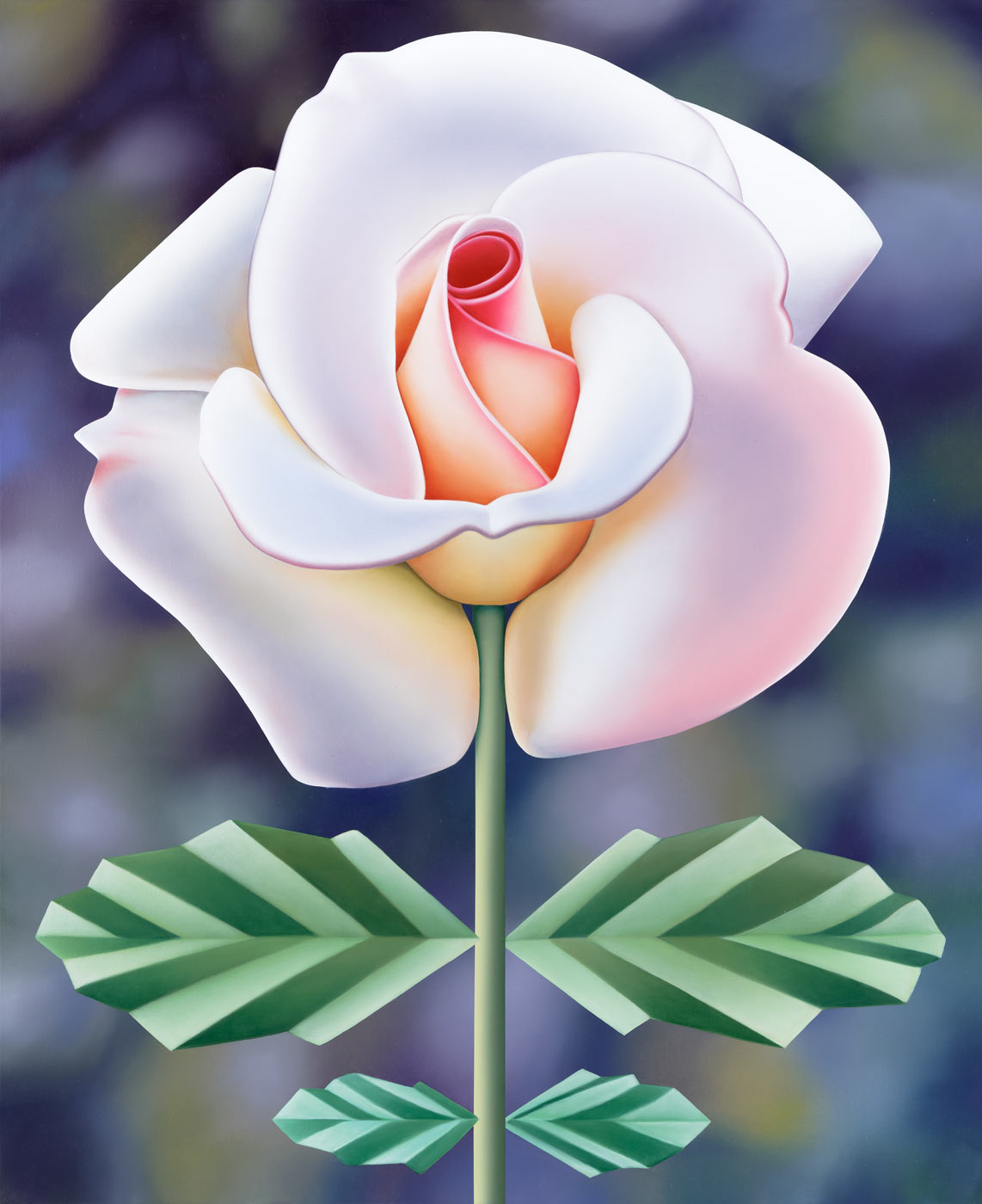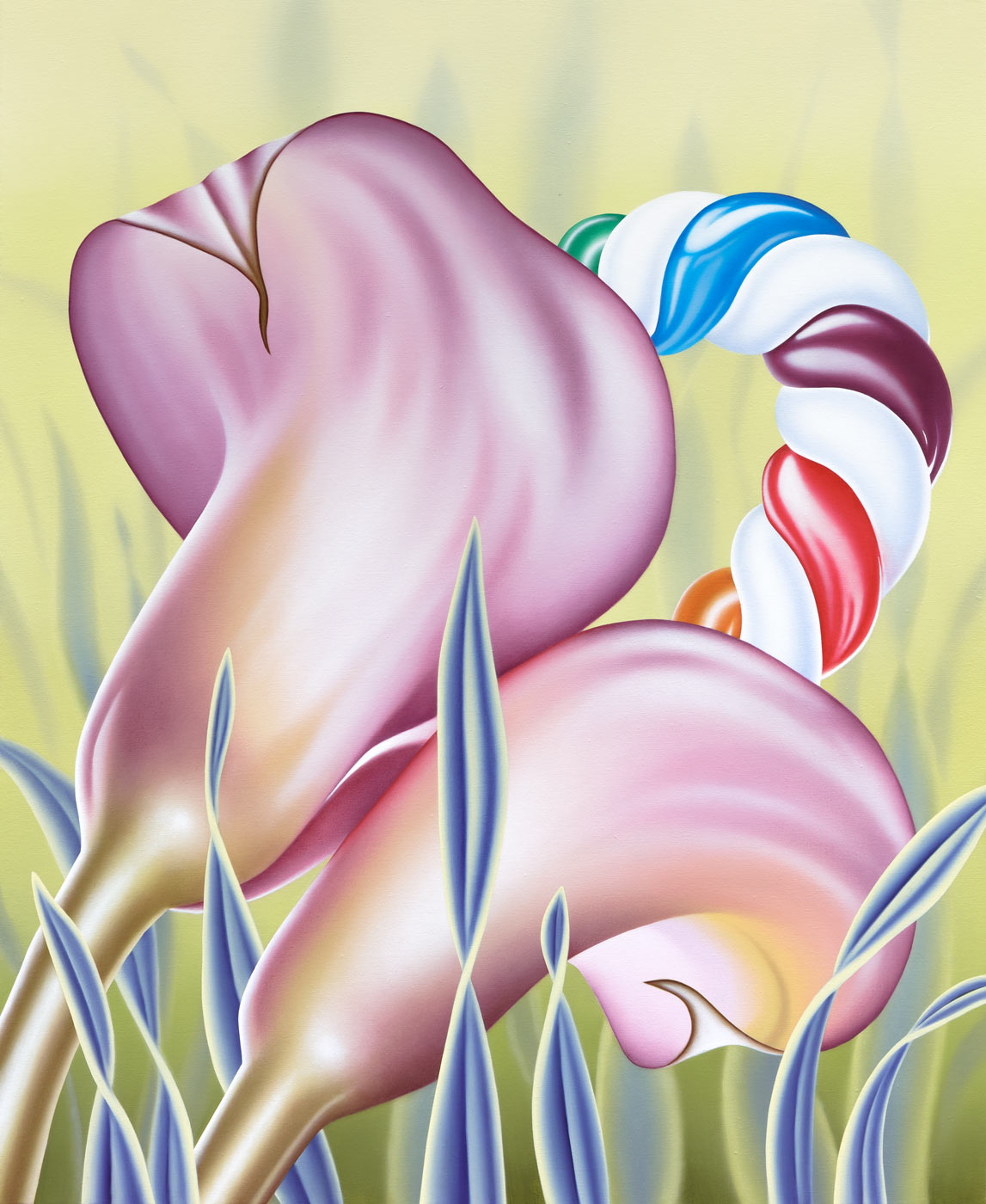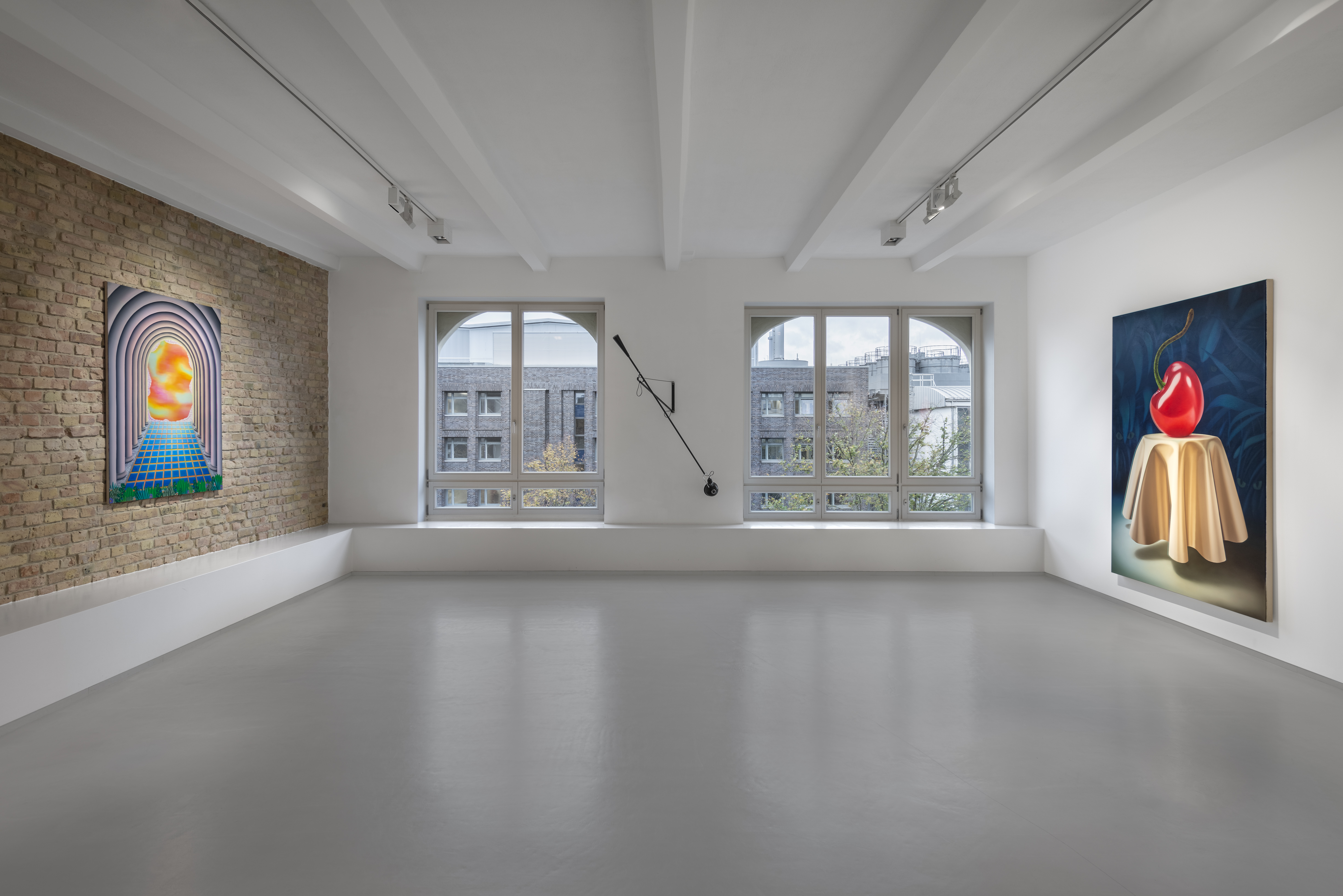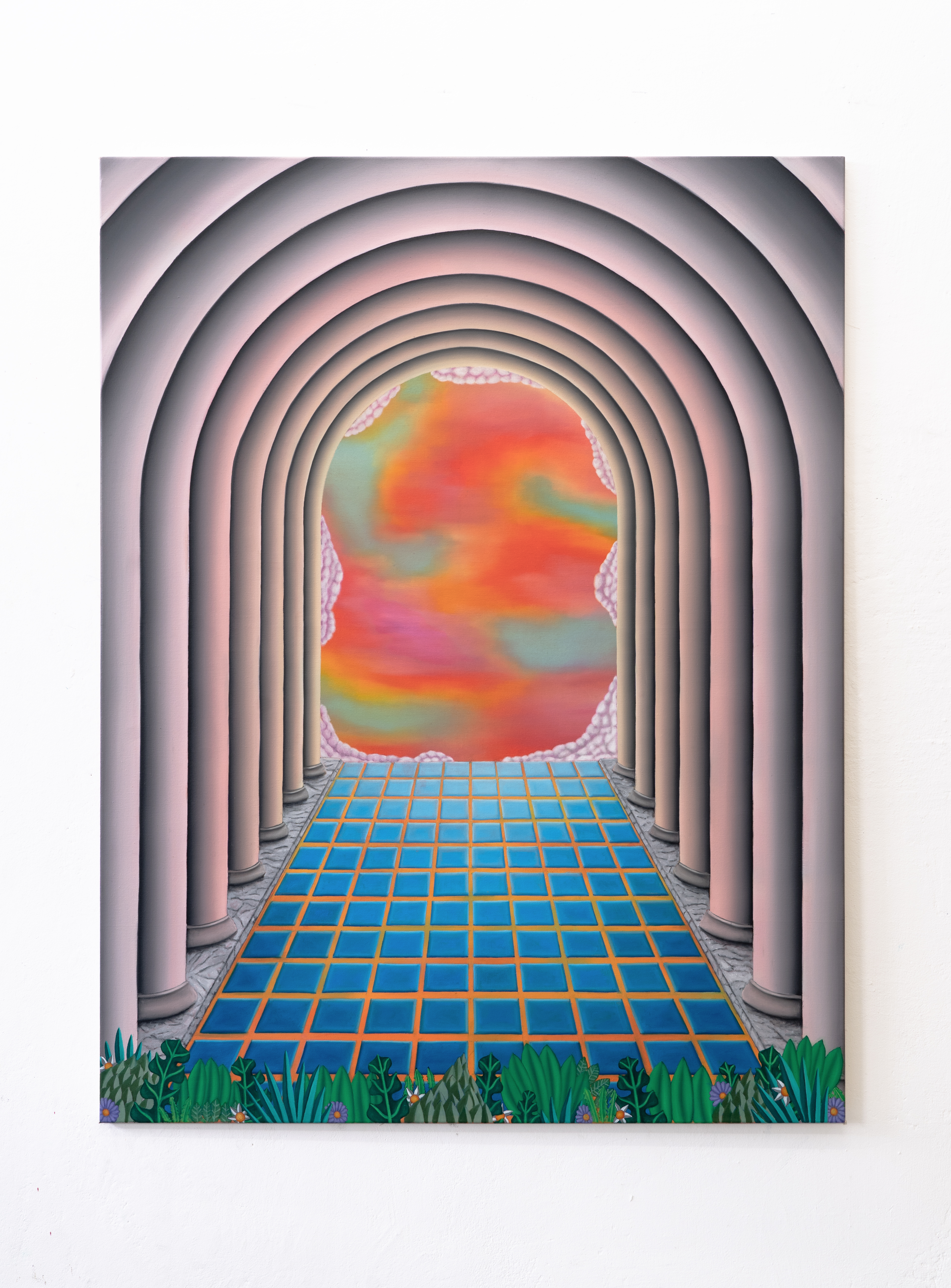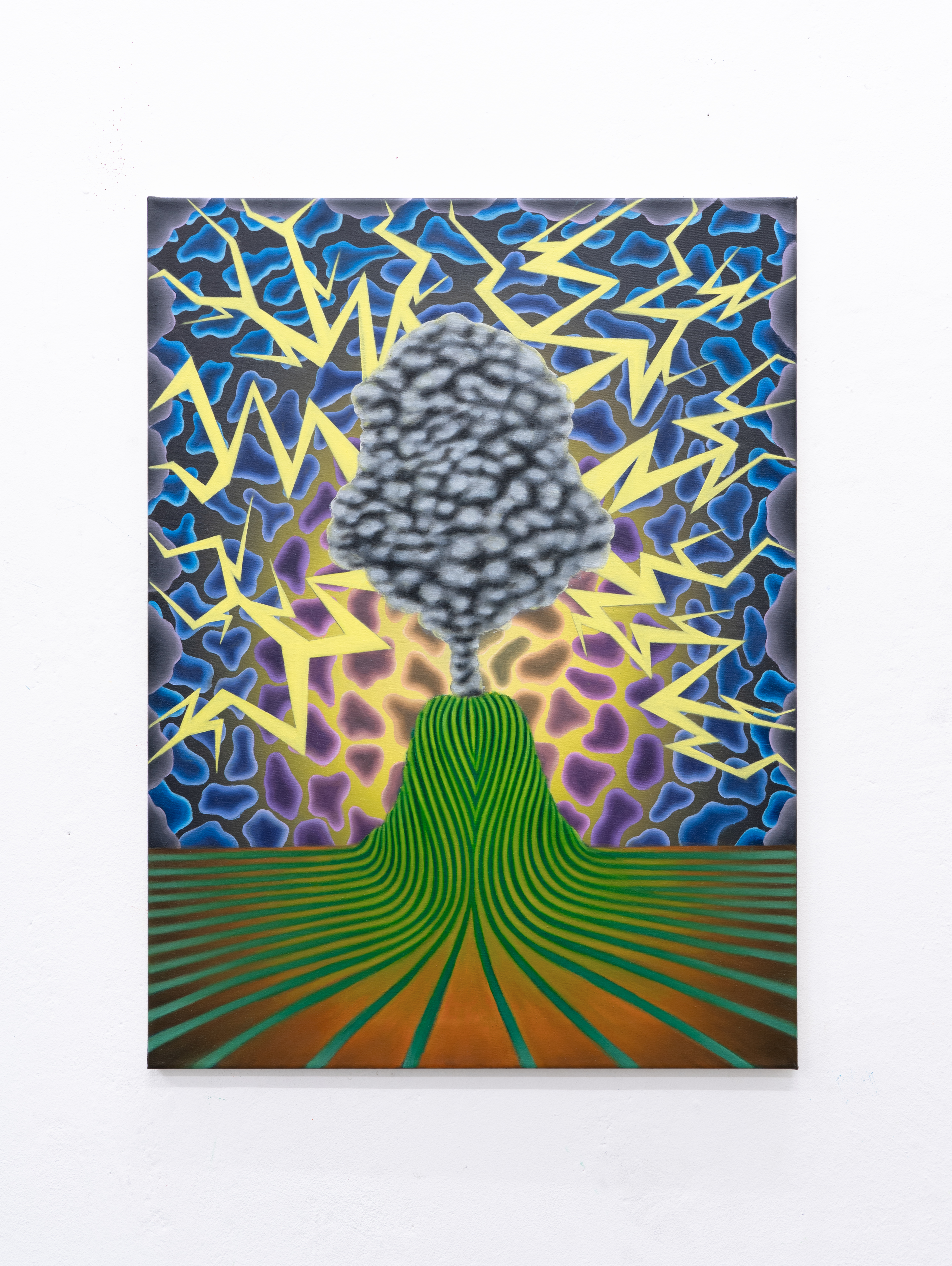Minor Threats
IMAGES
INFO
*Minor Threats*
Mona Broschár's works are clearly structured, reduced and polished to a high gloss. Her quest for perfection reveals itself directly to the viewer. Her paintings depict creatures, objects, plants and food whose aesthetics are taken to such an extreme that they seem to come alive before our eyes. The works hover between the real and the imaginary, between immaculate beauty and a strange wonder that raises questions and hints at the threatening. Glowing eyes stare aggressively through dark branches at a seemingly floating table on which a large cherry is enthroned and from which a predatory cat's tail grows out instead of a stem. In a fine porcelain cup, oversized sausages threaten to burst at any moment. Cherries, sausages and cream are naturally combined. Mona Broschár's works reflect the desires, longings and cravings of our time from a personal perspective and activate countless visual and haptic sensory stimuli when viewed. The feast is served. Stefan Jeske's works, on the other hand, are equally tidy and orderly in their formal language, and show a limited repertoire of sometimes recurring objects. The result is a surreal pictorial world that subliminally carries human and socio-political thoughts that occupy the artist in his everyday life, but which do not reveal themselves on closer inspection. It smokes, it crashes, it burns. The titles of the works, which can be fragments of songs or messages, are an essential component. They frame each picture. Similar to populism, Stefan Jeske deliberately works with a naive and trivial processing of information. Here, however, the attempt to find simple answers to major global problems is based on acceptance and the awareness that it will probably never succeed. He makes the struggle with one's own thoughts visible and creates magical places where friction and resistance actually prevail. In the exhibition “Minor Threats”, Mona Broschár and Stefan Jeske present colourful and tense visual worlds in which superficiality plays a decisive role. A poppy, smooth aesthetic underlies the works, under which the threat lurks in silence. The number of pictorial objects is deliberately reduced in order not to overload the pictorial space. While Mona Boschár makes visible the excess and greed, the insatiable desire for beautiful things and food, Stefan Jeske deals with the noise, the countless contradictions and impressions in our society in a humorous and symbolic way. Both artistic positions comment on social conditions, starting from the object and a diffuse state, without being preachy or intrusive, always moving on the border between reality and fiction.
Text by Carolin Kralapp
Mona Broschár's works are clearly structured, reduced and polished to a high gloss. Her quest for perfection reveals itself directly to the viewer. Her paintings depict creatures, objects, plants and food whose aesthetics are taken to such an extreme that they seem to come alive before our eyes. The works hover between the real and the imaginary, between immaculate beauty and a strange wonder that raises questions and hints at the threatening. Glowing eyes stare aggressively through dark branches at a seemingly floating table on which a large cherry is enthroned and from which a predatory cat's tail grows out instead of a stem. In a fine porcelain cup, oversized sausages threaten to burst at any moment. Cherries, sausages and cream are naturally combined. Mona Broschár's works reflect the desires, longings and cravings of our time from a personal perspective and activate countless visual and haptic sensory stimuli when viewed. The feast is served. Stefan Jeske's works, on the other hand, are equally tidy and orderly in their formal language, and show a limited repertoire of sometimes recurring objects. The result is a surreal pictorial world that subliminally carries human and socio-political thoughts that occupy the artist in his everyday life, but which do not reveal themselves on closer inspection. It smokes, it crashes, it burns. The titles of the works, which can be fragments of songs or messages, are an essential component. They frame each picture. Similar to populism, Stefan Jeske deliberately works with a naive and trivial processing of information. Here, however, the attempt to find simple answers to major global problems is based on acceptance and the awareness that it will probably never succeed. He makes the struggle with one's own thoughts visible and creates magical places where friction and resistance actually prevail. In the exhibition “Minor Threats”, Mona Broschár and Stefan Jeske present colourful and tense visual worlds in which superficiality plays a decisive role. A poppy, smooth aesthetic underlies the works, under which the threat lurks in silence. The number of pictorial objects is deliberately reduced in order not to overload the pictorial space. While Mona Boschár makes visible the excess and greed, the insatiable desire for beautiful things and food, Stefan Jeske deals with the noise, the countless contradictions and impressions in our society in a humorous and symbolic way. Both artistic positions comment on social conditions, starting from the object and a diffuse state, without being preachy or intrusive, always moving on the border between reality and fiction.
Text by Carolin Kralapp
Minor Threats Mona Broschár & Stefan Jeske Text: Carolin Kralapp Klar strukturiert, reduziert und auf Hochglanz poliert erscheinen die Arbeiten von Mona Broschár. Ihr Streben nach Perfektion offenbart sich den Betrachtenden unmittelbar auf der Leinwand. Ihre Bilder zeigen Wesen, Gegenstände, Pflanzen und Speisen, deren Ästhetik so weit getrieben wird, dass sie vor unseren Augen lebendig zu werden scheinen. Die Bilder bewegen sich an der Grenze zwischen Realem und Imaginärem, zwischen makelloser Schönheit und einer seltsamen Wunderlichkeit, die Fragen aufwirft und Bedrohliches erahnen lässt. Leuchtende Augen blicken angriffslustig durch dunkles Geäst auf einen scheinbar schwebenden Tisch, auf dem eine große Kirsche thront, aus der statt eines Stiels ein Raubkatzenschwanz herauswächst. In einer feinen Porzellantasse drohen jeden Moment überdimensionale Würste zu platzen. Kirschen, Würstchen und Sahne werden selbstverständlich zusammengesetzt. Mona Broschárs Arbeiten spiegeln die Wünsche, Sehnsüchte und Begierden unserer Zeit aus einer persönlichen Perspektive wider und aktivieren beim Betrachten unzählige visuelle und haptische Sinnesreize. Das Festmahl ist angerichtet. Demgegenüber stehen die Arbeiten von Stefan Jeske, die in ihrer Formensprache ebenso aufgeräumt und sortiert sind und ein begrenztes Repertoire an zum Teil wiederkehrenden Gegenständen zeigen. Es entstehen surreale Bildwelten, die menschliche und gesellschaftspolitische Gedanken, die den Künstler in seinem Alltag umtreiben, unterschwellig in sich tragen, sich aber beim Betrachten nicht plakativ offenbaren. Es raucht, es kracht, es brennt. Die Titel der Arbeiten, die aus Fragmenten von Liedern oder Nachrichten bestehen können, sind ein wesentlicher Bestandteil. Sie rahmen jedes Bild ein. Ähnlich dem Populismus arbeitet Stefan Jeske bewusst mit einer naiven und trivialen Aufbereitung von Informationen. Der Versuch, einfache Antworten auf die großen globalen Probleme zu finden, basiert hier jedoch auf der Akzeptanz und dem Bewusstsein, dass dies wahrscheinlich nie gelingen wird. Er macht ein Ringen mit den eigenen Gedanken sichtbar und schafft magische Orte, wo eigentlich Reibung und Widerstand vorherrschen. Mona Broschár und Stefan Jeske präsentieren in farbintensive und spannungsgeladene Bildwelten, in denen die Oberflächlichkeit eine entscheidende Rolle spielt. Eine poppige, glatte Ästhetik liegt den Arbeiten zugrunde, unter der die Bedrohung im Stillen lauert. Die Anzahl der Bildgegenstände wird bewusst reduziert, um den Bildraum nicht zu überfrachten. Während Mona Boschár den Exzess und die Gier, das unstillbare Verlangen nach schönen Dingen und Speisen sichtbar macht, verhandelt Stefan Jeske auf humorvolle und symbolistische Weise den Lärm, die unzähligen Widersprüche und Eindrücke innerhalb unserer Gesellschaft. Beide künstlerischen Positionen kommentieren gesellschaftliche Zustände, ausgehend vom Objekt und einem diffusen Zustand, ohne belehrend oder aufdringlich zu sein, und bewegen sich dabei stets an der Grenze zwischen Realität und Fiktion.

